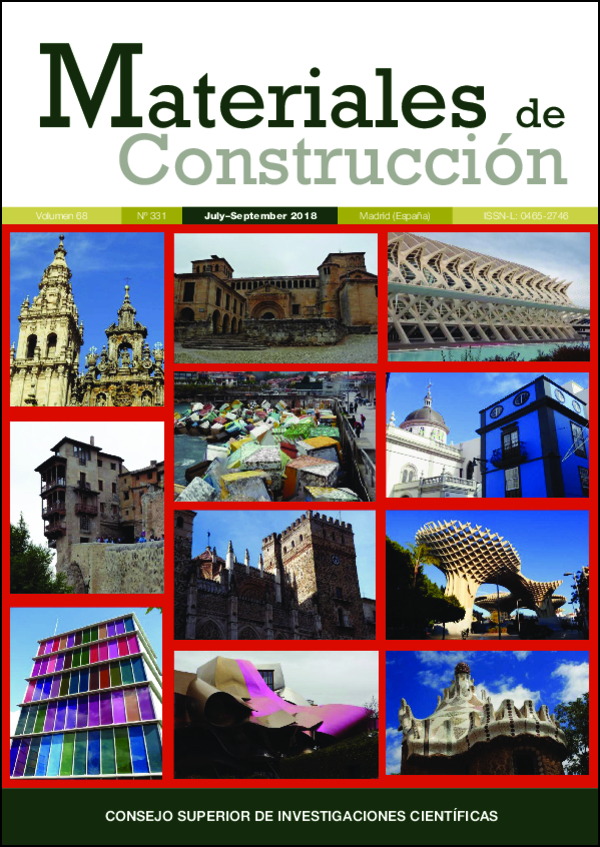Esquistos bituminosos como materia prima alternative en la fabricación de clínker de cemento Portland. Reacciones de clinkerización y caracterización del clínker
DOI:
https://doi.org/10.3989/mc.2018.07017Palabras clave:
Fabricación de cemento, Mezclas crudas, Esquisto bituminoso, Residuo de carbón, ReactividadResumen
La industria cementerabusca desde hace algún tiempo procedimientos que reduzcan el alto consumo de energía de la producción de cemento. La pizarra bituminosa de Timahdit (BOS) y los desechos de carbón de Jerada (CW) se pueden utilizar potencialmente como materiales alternativos en la fabricación de clinker. Este estudio se enfoca en evaluar esta posibilidad, valorizar dichos materiales y considerar un uso más ecológico para ellos. Exploramos la reactividad y la aptitud a la cocción de mezclas crudas de clínker que contienen BOS o CW. La reactividad de los crudos que contienen BOS es mejor que la de los que contienen CW, independientemente de su tamaño de partícula, siendo el que contiene BOS con un tamaño de partícula < 45 μm, la más reactiva. Los clínkeres que contienen BOS o la mezcla de BOS y CW (tamaño de partícula < 90 μm y 45 μm respectivamente) contienen proporciones de alita > 70%.
Descargas
Citas
Oss, H. G.; Padovani, A. C. (2002) Cement manufacture and the environment: part I: chemistry and technology. Ind. Ecol. 6 [1], 89–105. https://doi.org/10.1162/108819802320971650
Peake, S. (2001) Inside COP6: International Climate Change Negotiations. Refocus. 2 [1], 36–37. https://doi.org/10.1016/S1471-0846(01)80092-5
Oss, H. G.; Padovani, A. C. (2003) Cement manufacture and the environment part II: environmental challenges and opportunities. Ind. Ecol. 7 [1], 93–126. https://doi.org/10.1162/108819803766729212
Hilger, J. (2003) Combined utilization of oil shale energy and oil shale minerals within the production of cement and other hydraulic binders. Oil shale. 20 [3; SUPP], 347–355.
Bruan, V.; Halim, M.; Ziyad, M; Largeau, C.; Ambles, A. (2001) Characterization of the Moroccan Timahdit (X-layer) oil shale kerogen using pyrolysis and thermally assisted hydrolysis and methylation. Anal. Appl.Pyrolysis. 61[1–2], 165–179. https://doi.org/10.1016/S0165-2370(01)00131-0
Darmane, Y.; Alaoui, A.; Kitane, S.; Bennajah, M.; Daramy, A.; Cherkaoui, M. (2009) Recycling the slagheap of an old coal mine (Morocco). Sep. Purif. Technol. 68[1], 125–128. https://doi.org/10.1016/j.seppur.2009.04.026
Belkheiri, D.; Taibi, M.; Diouri, A.; Boukhari, A.; Aride, A.; Sassi, O. (2014) Characterization of Moroccan coal waste: valorization in the elaboration of the Portland clinker. MATEC Web of Conferences. 11, 01009. EDP Sciences.
EIA. (2012) Independent Statistics and Analysis. U.S. Energy Information and Administration <http://www.eia.gov/>.
Mounia, B.; Mostapha, B.; Rachid, H.; Hassan, B.; Abdelhakim, J.; Mohamed, S. (2013) Impact of mining wastes on groundwater quality in the province Jerada (eastern Morocco). Eng. Sci. Technol. 5 [8], 1601–1615.
Belkheiria, D.; Diouri, A.; Taibi, M.; Sassi, O.; Aride, J. (2015) Recycling of Moroccan coal gangue in the elaboration of a Portland clinker. Mater. Environ. Sci. 6 [6], 1570–1577.
Nabih, K.; Kada, M. K.; Hmiri, M.; Hamsi, N. (2014) Effects of the addition of oil shale ash and coal ash on physic-chemical properties of CPJ45 cement. In MATEC Web of Conferences. 11, 01012. EDP Sciences.
FUNDAL, E. (1979) World Cement Technol. 10, (1979).
UNE 80243:2014. Cement test methods. Chemical analysis. Determination of free calcium oxyde. Ethylenglycol method.
Glasser, F.P. (1983) Reactions occurring during cement making. Structure and performance of cements, 70–75.
Kakali, G.;Parissakis, G.; Bouras, D. (1996) A study on the burnability and the phase formation of PC clinker containing Cu oxide. Cem. Concr. Res. 26 [10], 1473–1478. https://doi.org/10.1016/0008-8846(96)00143-3
Kakali, G.; Parissakis, G. (1995) Investigation of the effect of Zn oxide on the formation of Portland cement clinker. Cem. Concr. Res. 25 [1], 79–85. https://doi.org/10.1016/0008-8846(94)00115-F
Blanco-Varela, M. T. (1984) Reactivity of fly-ashes when they are used as constituent of Portland cement raw mixes. TIZ-Fachberichte. 108 [5], 304–307.
Moreno, T. V. (1975) Contribution to the study of the reactions of portland cement hydration by infrared spectroscopy, (1975).
Timashev, V.V. (1980) Cinétique de la clinkérisation. Structure et composition du clinker et ses phases. 7th International Congress on the Chemistry of Cement. Paris.1–19.
Butt,Y.M.; Timashev, V.V.; Osokin, A. P. (1974) The mechanism of clinker formation processes and the modification of its structure. The 6th International Congress on the Chemistry of Cement. Moscow. 2–43.
Puertas, F.; García-Díaz, I.; Barba, A.; Gazulla, M.F.; Palacios, M.; Gómez, M.P.; Martínez-Ramírez, S. (2008) Ceramic wastes as alternative raw materials for Portland cement clinker production. Cem. Concr. Comp. 9 [30], 798–80. https://doi.org/10.1016/j.cemconcomp.2008.06.003
Publicado
Cómo citar
Número
Sección
Licencia
Derechos de autor 2018 Consejo Superior de Investigaciones Científicas (CSIC)

Esta obra está bajo una licencia internacional Creative Commons Atribución 4.0.
© CSIC. Los originales publicados en las ediciones impresa y electrónica de esta Revista son propiedad del Consejo Superior de Investigaciones Científicas, siendo necesario citar la procedencia en cualquier reproducción parcial o total.
Salvo indicación contraria, todos los contenidos de la edición electrónica se distribuyen bajo una licencia de uso y distribución “Creative Commons Reconocimiento 4.0 Internacional ” (CC BY 4.0). Consulte la versión informativa y el texto legal de la licencia. Esta circunstancia ha de hacerse constar expresamente de esta forma cuando sea necesario.
No se autoriza el depósito en repositorios, páginas web personales o similares de cualquier otra versión distinta a la publicada por el editor.
















